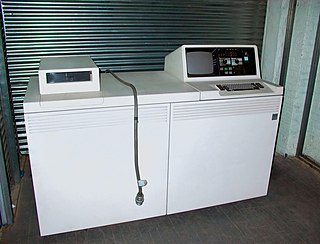
An integrated development environment (IDE) is a software application that provides comprehensive facilities to computer programmers for software development. An IDE normally consists of at least a source code editor, build automation tools, and a debugger. Some IDEs, such as NetBeans and Eclipse, contain the necessary compiler, interpreter, or both; others, such as SharpDevelop and Lazarus, do not.
VBScript is an Active Scripting language developed by Microsoft that is modeled on Visual Basic. It allows Microsoft Windows system administrators to generate powerful tools for managing computers with error handling, subroutines, and other advanced programming constructs. It can give the user complete control over many aspects of their computing environment.

The IBM System i is IBM's previous generation of midrange computer systems for IBM i users, and was subsequently replaced by the IBM Power Systems in April 2008.

In Unix and Unix-like operating systems, chmod is the command and system call which is used to change the access permissions of file system objects. It is also used to change special mode flags. The request is filtered by the umask. The name is an abbreviation of change mode.
In human–computer interaction and user interface design, cut, copy and paste are related commands that offer an interprocess communication technique for transferring data through a computer's user interface. The cut command removes the selected data from its original position, while the copy command creates a duplicate; in both cases the selected data is kept in a temporary storage device called the clipboard. The data in the clipboard is later inserted in the position where the paste command is issued. The data is available to any application supporting the feature, thus allowing easy data transfer between applications.
In computing, Interactive System Productivity Facility (ISPF) is a software product for many historic IBM mainframe operating systems and currently the z/OS operating system that runs on IBM mainframes. It includes a screen editor, the user interface of which was emulated by some microcomputer editors sold commercially starting in the late 1980s, including SPFPC.

The IBM System/34 was an IBM midrange computer introduced in 1977. It was withdrawn from marketing in February 1984. It was a multi-user, multi-tasking successor to the single-user System/32. Most notably, it included two very different processors, one based on System/32 and the second based on older System/3. Like the System/32 and the System/3, the System/34 was primarily programmed in the RPG II language.

The IBM System/36 was a small computer system marketed by IBM from 1983 to 2000 - a multi-user, multi-tasking successor to the System/34.

The System/38 was a minicomputer and midrange computer server platform manufactured and sold by the IBM Corporation. The system offered a number of innovative features, and was the brainchild of Frank Soltis and Glenn Henry. IBM announced the System/38 in 1978. Developed under the code-name "Pacific", it was made commercially available in August 1979. The System/38 was oriented toward a multi-user system environment. The typical system handled from a dozen to several dozen terminals.

Code folding is a feature of some text editors, source code editors, and IDEs that allows the user to selectively hide and display – "fold" – sections of a currently edited file as a part of routine edit operations. This allows the user to manage large amounts of text while viewing only those subsections of the text that are specifically relevant at any given time.

Computer-aided software engineering (CASE) is the domain of software tools used to design and implement applications. CASE tools are similar to and were partly inspired by computer-aided design (CAD) tools used for designing hardware products. CASE tools are used for developing high-quality, defect-free, and maintainable software. CASE software is often associated with methods for the development of information systems together with automated tools that can be used in the software development process.
MBASIC is the Microsoft BASIC implementation of BASIC for the CP/M operating system. MBASIC is a descendant of the original Altair BASIC interpreters that were among Microsoft's first products. MBASIC was one of the two versions of BASIC bundled with the Osborne 1 computer. The name "MBASIC" is derived from the disk file name MBASIC.COM of the BASIC interpreter.
In computer programming, Intentional Programming is a programming paradigm developed by Charles Simonyi that encodes in software source code the precise intention which programmers have in mind when conceiving their work. By using the appropriate level of abstraction at which the programmer is thinking, creating and maintaining computer programs become easier. By separating the concerns for intentions and how they are being operated upon, the software becomes more modular and allows for more reusable software code.
IBM Spectrum Protect is a data protection platform that gives enterprises a single point of control and administration for backup and recovery. It is the flagship product in the IBM Spectrum Protect family.
System Support Program (SSP) was an operating system for the IBM System/34 and System/36 minicomputers. SSP was a command-based operating system released in 1977.
E is the text editor which was made part of PC DOS with version 6.1 in June 1993, and later with version 7 and PC DOS 2000. In version 6.1, IBM dropped QBASIC, which, in its edit mode, was also the system text editor. It was necessary to provide some sort of editor, so IBM chose to adapt and substantially extend its OS/2 System Editor (1986), a minimally functional member of the E family of Editors. The DOS version is extended with a wide array of functions that are usually associated with more functional versions of the E editor family. In version 7, IBM added the REXX language to DOS, restoring programmability to the basic box. IBM also provided E with OS/2.
PDM was installed on most AS/400 and IBM System i systems as a part of the Applications Development ToolSet (ADT) and is still installed on most IBM i systems today. PDM is an environment that lets programmers and/or operators navigate three levels of the PDM: 1) the library level, 2) the object level, and 3) the member level.
Swift is a general-purpose, multi-paradigm, compiled programming language developed by Apple Inc. for iOS, macOS, watchOS, tvOS, Linux, and z/OS. Swift is designed to work with Apple's Cocoa and Cocoa Touch frameworks and the large body of existing Objective-C code written for Apple products. It is built with the open source LLVM compiler framework and has been included in Xcode since version 6, released in 2014. On Apple platforms, it uses the Objective-C runtime library which allows C, Objective-C, C++ and Swift code to run within one program.

Distributed Data Management Architecture (DDM) is IBM's open, published software architecture for creating, managing and accessing data on a remote computer. DDM was initially designed to support record-oriented files; it was extended to support hierarchical directories, stream-oriented files, queues, and system command processing; it was further extended to be the base of IBM's Distributed Relational Database Architecture (DRDA); and finally, it was extended to support data description and conversion. Defined in the period from 1980 to 1993, DDM specifies necessary components, messages, and protocols, all based on the principles of object-orientation. DDM is not, in itself, a piece of software; the implementation of DDM takes the form of client and server products. As an open architecture, products can implement subsets of DDM architecture and products can extend DDM to meet additional requirements. Taken together, DDM products implement a distributed file system.









